NRAO eNews
February 2009 • Vol. 2, Iss. 2
- Upcoming Events
- ALMA Project Status
- EVLA Science Commissioning
& Early Science - The EVLA Vision: Stars On and Off the Main Sequence
- MUSTANG Commissioned
on the GBT - GBT Surface Improvements
- Joint Observing Opportunities with Fermi and Chandra Satellites
- Fifth NAIC-NRAO School on Single-Dish Radio Astronomy
- Career Opportunities
- Past Issues
- Contact the Editor
- Subscribe
- More Information
NRAO eNews: February 2009 • Volume 2, Issue 2

The first Vertex production antenna is carried into the testing area of the ALMA OSF Technical Facility by the transporter on 6 Feb.
Upcoming Events
 Astro2010 Town Hall
Astro2010 Town Hall
March 11, 2009 | 1:00–4:00 p.m. ET | Hosted by NRAO &
UVA Astronomy | NRAO Auditorium, Charlottesville, VA
 20th International Symposium on Space THz Technology
20th International Symposium on Space THz Technology
April 20-22, 2009
Charlottesville, VA
 The 2009 NRAO Postdoctoral Symposium
The 2009 NRAO Postdoctoral Symposium
April 29 - May 1, 2009
Socorro, NM
 The EVLA Vision: Stars On and Off the Main Sequence
The EVLA Vision: Stars On and Off the Main Sequence
May 26-28, 2009
Socorro, NM
 Millimeter and Submillimeter Astronomy at High Angular Resolution
Millimeter and Submillimeter Astronomy at High Angular Resolution
June 8-12, 2009 |
Academia Sinica, Taipei, Taiwan
 NAIC-NRAO School on Single-Dish Radio Astronomy
NAIC-NRAO School on Single-Dish Radio Astronomy
July 12-18, 2009
Arecibo Observatory, Puerto Rico
ALMA Project Status
Al Wootten
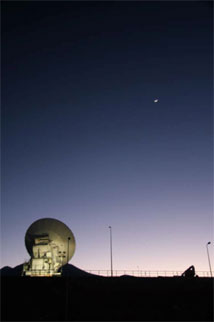
Figure 1: The first ALMA production antenna validates the ALMA system through observations of the Moon.
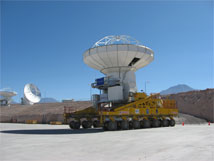
Figure 2: The first Vertex production antenna is carried into the testing area of the OSF Technical Facility by the transporter on 6 Feb.
I. Astronomical Validation of the ALMA System
On January 22, 2009 scientists and engineers at the Operations Support Facility (OSF) in northern Chile achieved astronomical validation of an ALMA continuum system. The Moon was observed in three of the four bands available in the Front End, tuned to 100 GHz, 240 GHz and 310 GHz.
The sky from this low altitude (2900m) site did not cooperate with an attempt to observe at 675 GHz though signal throughput was attempted by detecting the antenna shutter. The ALMA antenna accepted last month from Japan was used with the receiver assembly from the Front End Integration Center assembled at the NRAO Technology Center in Charlottesville, and a Back End assembled at the Socorro, NM Science Operations Center. The observations were controlled from the OSF Technical Facility supplied by ESO.
II. ALMA Construction
On 6 February 2009, the first production antenna designed and built by the Vertex division of General Dynamics Corp. under contract with Associated Universities, Inc. was accepted by the project since it had passed its acceptance tests. An ALMA transporter moved this antenna to a foundation at the nearby OSF and pointing tests began immediately. This antenna will be equipped with the Front End recently delivered from the East Asian Front End Integration Center in Taiwan.
The remaining three Melco and eight Vertex antennas on the site will follow during the course of the year. Major components of the first AEM antenna under contract from ESO have been shipped from Antwerp and these antennas will join the growing ALMA antenna family during the year. Antenna foundation construction continues at the high-elevation Array Operations Site (AOS). Concrete has been poured for 52 foundations. Each of these milestones are important steps that lead to astronomical validation of the fledgling ALMA array later this year.
EVLA Science Commissioning & Early Science
Claire Chandler and Robert Dickman
The EVLA’s WIDAR correlator will be extremely powerful. With just a small fraction of its boards in place, its capabilities will exceed those of the VLA correlator for both spectral line and continuum observations. The delivery of WIDAR production boards to NRAO from our Canadian partner is underway and will continue throughout 2009. Science Commissioning of the EVLA, which will include commissioning the WIDAR correlator’s full suite of capabilities, will occupy the remainder of the EVLA construction phase that ends in 2012. As part of this commissioning process the VLA correlator will be turned off in January 2010 and will be replaced by WIDAR. At the same time the direction of the configuration cycles will also change, from A→B→C→D→A… to D→C→B→A→D…, in order to facilitate the WIDAR correlator commissioning and to limit initial EVLA data rates. The transition from the VLA correlator to WIDAR, and the reversal of the configuration cycle, marks the beginning of EVLA Early Science.
EVLA Early Science Phase (March 2010 through 2012)
At the end of this year the VLA/EVLA will spend two trimesters in D configuration, starting with the VLA correlator (October 2009 through mid-January 2010) and followed by the commissioning of some basic observing modes using the WIDAR correlator. The EVLA Early Science Phase, which includes both an Open Shared Risk Observing (OSRO) program for the general user community and the Resident Shared Risk Observing (RSRO) program described below, is expected to begin in March 2010 in the D configuration. This article describes the enhanced scientific opportunities that will be offered to users during the EVLA Early Science Phase as a result of the upcoming correlator transition, under these two different programs.
EVLA capabilities available under the Open Shared Risk Observing Program
The Open Shared Risk Observing (OSRO) program continues the shared risk observing access to the EVLA that has been offered to all users of the VLA since the EVLA construction project began. Under the OSRO program the general user community will be offered early access to a number of WIDAR capabilities and observing modes that represent a significant improvement over those of the VLA correlator. The initial WIDAR configurations to be offered to all users for OSRO are described in more detail at the EVLA Information for Astronomers web page. Time will be allocated for OSRO via the normal NRAO peer-review process. It will be possible to reduce simple OSRO datasets using AIPS, although users are encouraged to use CASA, which will also be available. The capabilities of the WIDAR correlator available for OSRO will be expanded as soon as they can be supported for general use. The OSRO program will run from March 2010 through the end of the EVLA construction phase.
Additional EVLA capabilities available under the Resident Shared Risk Observing Program
Along with the OSRO program described above, NRAO also announces a Resident Shared Risk Observing (RSRO) program during the EVLA Early Science Phase. This program offers participants full access to the growing capabilities of the WIDAR correlator for peer-reviewed science projects, in exchange for a period of residence in Socorro to assist with the Science Commissioning of the EVLA.
The RSRO program is intended to accelerate the development of the EVLA’s full scientific capabilities by gaining enhanced commissioning resources and expertise through community participation. It will at the same time help quickly optimize the scientific productivity of the EVLA. The EVLA capabilities currently expected to be available under the RSRO program as a function of time are described at the EVLA Information for Astronomers web page. The RSRO program will run for approximately two years (from March 2010 through the end of 2011), with up to 25% of the EVLA time available for astronomical observations allocated to the RSRO program, depending on demand and quality of science proposed. At the end of this period all access to the EVLA will be through the OSRO program, until full operations begin in 2013.
The primary requirement of the RSRO program is that there be at least one expert from each participating group in residence in Socorro. These experts must be able to contribute effectively to the Science Commissioning of the EVLA. Some NRAO support for salaries or accommodation may be available. Further details of the RSRO program are available at the EVLA Information for Astronomers web page.
In order to assess community interest in the RSRO program, and to inform whether a special workshop for potential resident shared risk observers on EVLA capabilities should be held later this spring, we request that Letters of Interest be sent directly to the Assistant Director for NM Operations (nraonmad@nrao.edu). A list of potential commissioning tasks that would benefit from RSRO participation can be found in the description of the RSRO program, available at the EVLA Information for Astronomers web page.
Letters of Interest are due by March 15, 2009.
Questions regarding the EVLA early science opportunities should be directed to Claire Chandler (cchandle@nrao.edu).
The EVLA Vision: Stars On and Off the Main Sequence
Karl Menten (MPIfR), Michael Bode (Liverpool), Sean Dougherty (NRC-HIA), Rob Fender (Southampton), Bryan Gaensler (Sydney), Rachel Osten (STScI), Luis Rodriguez (UNAM), Michael Rupen (NRAO), Stephen White (Maryland), Albert Zijlstra (Manchester)
The EVLA will improve on the continuum sensitivity of the VLA by a factor of 10; allow access to all frequencies between 1 and 50 GHz, with instantaneous bandwidths of up to 8 GHz; and provide tens of thousands to millions of spectral channels, allocated in up to 64 independently tunable and enormously flexible sub-bands. This vast increase in observing power brings unprecedented scientific capability to centimeter wavelengths, making the EVLA a world-leading radio telescope in the next decade.
With limited shared-risk observing starting early in 2010, and full operational capability in 2013, the NRAO is sponsoring and hosting a series of workshops to bring together astronomers from across the electromagnetic spectrum to start exploring the wide range of scientific questions for which the EVLA will be a pivotal instrument.
The second workshop in this series will focus on observations of stars, both on and off the main sequence. The VLA revolutionized the field of stellar radio astronomy, with detections across almost the entire Hertzsprung-Russell diagram, and opened entirely new fields of research. The EVLA promises similarly impressive advances, with massive improvements in sensitivity, instantaneous bandwidth, frequency coverage, spectral capability, and transient source response.
The object of this conference is to explore what this will mean for studies of stars. Some examples include:
- New source populations: e.g., first detections of solar-type radio emission from other stars; census of pulsars in the Galactic Center; sensitive searches for radio emission from type Ia supernovae.
- Fuller exploration of known populations: e.g., detection of all novae, anywhere in the Galaxy; complete census of supernova remnants in nearby galaxies.
- Complete coverage of selected individual events: e.g., "cradle to grave" imaging of nearby transients (X-ray binaries, novae, soft gamma ray repeaters, etc.).
- Imaging of many galactic sources that we can now only detect: e.g., stellar photospheres.
- Circumstellar envelopes: e.g., complete coverage of spectral lines from 1 to 50 GHz in stellar outflows.
- Fast & sensitive time response: e.g., explosive events (cataclysmic variables, novae, X-ray binaries, supernovae); stellar radio bursts. The data collected will also be much more interesting, since (1) the higher sensitivity will lead to 10X better time resolution; and (2) the EVLA will measure spectral indices, polarizations, rotation measures, and dynamic spectra, in addition to simple flux densities, without any loss of continuum sensitivity.
- The unexpected: order-of-magnitude improvements normally lead to many surprises!
While the EVLA alone will make many new discoveries, instrumentation at other wavelengths has improved enormously as well. Hence this conference will emphasize synoptic approaches addressing, e.g., comparison of high energy and non-thermal radio emission, or parallel imaging of radio and infrared molecular emission/absorption and continuum emission.
The 3-day workshop will be held in Socorro, NM on May 26 - 28, 2009 (Tuesday - Thursday). Registration will open on February 20, 2009. There will be no proceedings, but contributions (PowerPoint or pdf format) will be posted and archived on-line.
MUSTANG Commissioned on the GBT
Brian Mason, Simon Dicker & Phil Korngut for the MUSTANG Team
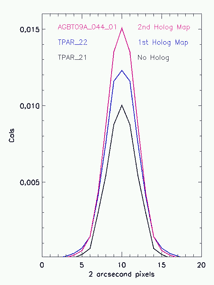
Figure 1: Radial profiles of Ceres, a primary MUSTANG calibrator, and a compact (<1") asteroid with a known thermodynamic temperature. These profiles were collected before holographic corrections, and after two versions of the holographic corrections derived by the PTCS team. The vertical axis is apparent source intensity in units of MUSTANG's internal noise calibration lamp; the x-axis is linear distance in 2 arcsecond pixels.
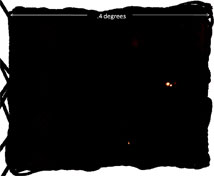
Figure 2: Large-area (0.4 deg x 0.3 deg) map collected in 45 minutes during commissioning in January 2009. This map makes use of the GBT's Quadrant Detector to correct for feedarm pointing errors induced by the rapid scanning. The rms noise in these data, which were collected prior to the new holography corrections, is ~ 8 mJy.
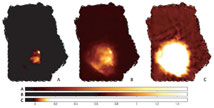
Figure 3: MUSTANG+GBT 90 GHz map of Orion on 3 color scales (Jy per 10" beam) emphasizing the dynamic range and sensitivity to extended structure that has been achieved. These maps resulted from Early Science observations in spring 2008.
MUSTANG, a 64-pixel bolometer array and the GBT's first 90 GHz instrument, has been commissioned for science observations starting in February 2009. GBT data have confirmed that the MUSTANG optics upgrade has yielded the expected 35% increase in field-of-view (from 32 arcseconds square to 42 arcseconds square) and a 70% decrease in noise per detector.
In conjunction with improvements reported in the accompanying article by Todd Hunter and the PTCS group, MUSTANG is on track for the projected factor of three improvement in sensitivity over last season and has good prospects for further improvements in the near future.
Figure 1 shows cuts through maps of Ceres, a MUSTANG primary calibrator, before and after the application of holographic corrections. We have also tested rapid, large-area mapping techniques with good results (Figure 2). Images suitable for publication, or for analysis with other astronomical images, are produced through Bill Cotton's OBIT software package (see Figure 3). As of January 2009 MUSTANG has been fully integrated into the GBT control system, a milestone which represents the culmination of many months of hard work on the data acquisition and control software. Efforts to construct an improved detector array for the receiver are also underway.
Over 120 hours of science proposals have been accepted, with programs targeting a variety of topics ranging from the Sunyaev-Zel'dovich Effect in clusters to protoplanetary debris disks. Future calls for proposals will include MUSTANG.
For more information about MUSTANG see http://www.gb.nrao.edu/mustang/ and http://chile1.physics.upenn.edu/
gbtpublic/.
GBT Surface Improvements
Todd Hunter, Fred Schwab, and Martin Bloss
With the goal of boosting the GBT high-frequency performance, the Precision Telescope Control System (PTCS) project team has been working to improve the surface accuracy. The problem naturally divides into two parts: large-scale errors due to thermal and gravitational distortion; and small-scale errors due to actuator and panel setting errors. These disparate regimes require the use of complementary techniques: out-of-focus (OOF) holography and traditional holography. Excellent progress has been made with both techniques. In December, we released an observing tool to measure and correct large-scale errors during daytime observing. In January, we acquired high-resolution traditional holography maps that have resulted in the first significant reduction in the small-scale surface error since the initial photogrammetry corrections were applied in 2001.
Out-of-Focus (OOF) Holography
The GBT uses OOF holography to measure the large-scale errors on the primary reflector. Maps of a quasar are acquired at three focus settings. By modeling the aberrations in the resulting three images, the mirror deformation is determined and expressed as a sum of Zernike polynomials. On the GBT, the deformation varies with elevation, indicating a residual error in the finite element model. Since late 2006, the active surface of 2209 actuators has been automatically removing this error by applying elevation-dependent Zernike terms, leading to a stable nighttime aperture efficiency (44% at Q-band).
To extend this performance into daytime, a new “AutoOOF” tool was released in December for use by high-frequency (Ka & Q-band) observers. As described in the Oct 08 eNews, AutoOOF allows the observer to measure the shape of the surface and apply the necessary corrections at the push of a button. A full AutoOOF cycle takes ~ 20 minutes and should be factored into the overhead time for observations.
An example of the improvement delivered by AutoOOF at Q-band is shown in Figure 1. With AutoOOF, the large-scale error can now be held to less than 1/50 wavelength rms. The next phase in AutoOOF development is integration with the 64 pixel MUSTANG bolometer camera, built in conjunction with the University of Pennsylvania, NASA, and NIST. Using the experimental OOF holography results from the 2007-2008 season of MUSTANG, we found that data from all of the working pixels can be safely included in the fit, providing a robust measurement of the surface with only a few minutes of observing time. Data from the current commissioning season indicate significant improvements to the nighttime efficiency at 90 GHz using the AutoOOF technique. Daytime tests of AutoOOF with MUSTANG will be attempted soon.
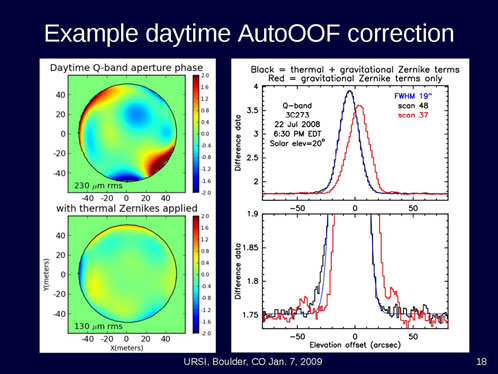
Figure 1: (Left panels) surface maps obtained before (top) and after (bottom) the application of AutoOOF corrections. The rms values represent the large-scale component of the surface error. (Right panels) The 43 GHz beam profiles before and after application of the AutoOOF corrections. Note the reduction in beam width and the increase in intensity.
Traditional Holography
The GBT’s 12 GHz phase-coherent (traditional) holography system was upgraded over the past year and commissioned in December. The system is composed of two room temperature, high dynamic range receivers and a narrowband correlator. Designed to observe strong beacon signals from geostationary satellites, one receiver looks directly at the target through a 30cm feed horn, while an identical receiver looks at the same signal reflected from the dish and subreflector. The telescope is slewed in a raster pattern to obtain a large (2 degree) map centered on the satellite. The information in the resulting map is readily transformed into an image showing the deviations of the surface from a perfect paraboloid (Figure 2). This image allows us to extract a table of corrections which can be applied to refine the home positions of the individual actuators.
The first set of such corrections was tested in late January with MUSTANG and yielded a 50% increase in the 90 GHz sensitivity, indicating that the aperture efficiency is now 15%. Follow-up holography maps of the surface taken in early February confirm that the total surface error in the dish has been improved from 385 to 340 microns rms (Figure 3). The holography images are complicated by the effect of diffraction at the subreflector that produces ring-like modulations toward the outer portion of the dish which must be removed before deriving actuator corrections. In areas free of these rings and not affected by bad actuators, the repeatability between two maps is ~ 145 microns rms, suggesting that further improvement of the surface via holography is possible.
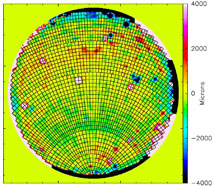
Figure 2: GBT surface image showing deviations over the range of -4 to +4 mm.The black lines indicate the borders of the 2,004 surface panels. An actuator resides at each intersection. The white and black spots reveal about a dozen individual actuators with highly discrepant positions. These units were subsequently inspected and are undergoing repair.
Because GBT engineers were able to fit the receiver into the normally unused Gregorian turret slot above Zpectrometer, we have the opportunity to iterate the holography measurements and corrections this season. For example, if we can reduce the total surface error from 340 to 240 micron rms, then we would reach 35% aperture efficiency for MUSTANG at 90 GHz and 20% for a (future) W-band receiver operating at 115.27 GHz (CO 1-0).
Additional information about the PTCS projects. For more information on GBT’s holography capabilities contact Todd Hunter at thunter@nrao.edu.
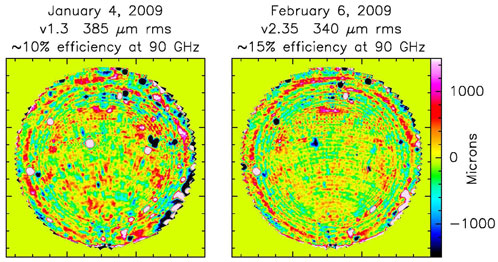
Figure 3: (Left panel) Holography map of surface version 1.3 obtained January 4, 2009. (Right panel) Holography map of surface version 2.35, which has the corrections from the January map applied. The surface error is reduced and the measured aperture efficiency at 90 GHz is increased.
Joint Observing Opportunities with
Fermi and Chandra Satellites
Jim Ulvestad
NRAO is again participating in joint/cooperative observing programs with the Chandra X-ray Observatory and the Fermi Gamma-ray Space Telescope. Both have proposal deadlines in March: March 6 for Fermi Cycle 2, and March 17 for Chandra Cycle 11. For Chandra, proposals will be for observations that require both Chandra pointing and NRAO observations to carry out a scientific investigation. For Fermi, which is primarily in sky-survey mode, potential observers may propose for NRAO observations that make use of the Fermi survey data even without re-pointing of the Fermi satellite.
NRAO has allocated up to 3% of the observing time on VLA/EVLA, VLBA, and GBT for Chandra joint proposals, and up to 10% of the observing time on the same telescopes for Fermi cooperative proposals. Potential proposers also should note that the overall scope of the Fermi guest investigator program is doubling for Cycle 2, as the satellite becomes fully operational.
The Chandra proposal call may be accessed from http://cxc.harvard.edu/proposer/CfP/ .
Section 4.5.5 of the proposal call gives specifics of the joint NRAO/Chandra program.
The Fermi proposal call may be accessed from http://fermi.gsfc.nasa.gov/ssc/proposals/ .
Details about the cooperative NRAO/Fermi program may be found at http://fermi.gsfc.nasa.gov/ssc/proposals/nrao.html .
Fifth NAIC-NRAO School on Single-Dish Radio Astronomy
Karen O'Neil
The fifth NAIC-NRAO school on single-dish radio astronomy will be held 12-18 July 2009 at the Arecibo observatory in Puerto Rico. The objective of the school is to provide graduate students, post-docs, and experts in other fields of astronomy with both knowledge and practical experience of the techniques and applications of single-dish radio astronomy.
The school will be based around an intensive series of lectures from experts. A significant part of each participant's time at the school will be spent performing a hands-on radio astronomy project. For this project, participants will make observations with either the Arecibo 305-m telescope or the Green Bank 100-m (GBT) telescope, analyze the data acquired, and interpret the results.
The primary goals of the school are to:
- provide participants with a strong grounding in the fundamental elements of single-dish radio astronomy, and its relationship to other branches of observational astronomy;
- give an overview of current and emerging capabilities with single-dish radio telescopes, the techniques used with them, and the associated instrumentation;
- provide direct "hands-on" experience with the world's largest single-dish radio telescopes, and introduce participants to the hardware and software used in taking and reducing observations.
The number of participants will be limited to approximately 45 people. A registration fee of $200 will include: travel between San Juan airport and Arecibo Observatory, the welcome reception, lunches during the school, social events, the school banquet, and a copy of the proceedings. Participants will be housed either at the Observatory or in nearby hotels. They are expected to cover the cost of their travel to Puerto Rico, lodging, and other meals. However, some financial assistance is expected to be available, especially for applicants based at U.S. institutions.
The school web page is to be found at http://www.naic.edu/~astro/sdss5/
Career Opportunities
ALMA Commissioning Scientists: The Joint ALMA Office invites applications for the position of Commissioning Scientists to be based in Santiago, Chile. These are international staff positions in the ALMA Project, the world's most sensitive mm/submm interferometer, which is currently under construction in northern Chile. The role of ALMA Commissioning Scientists is to assist the Project Scientist and Deputy Project Scientist in planning and executing the scientific commissioning of ALMA.
Assistant Scientist: The National Radio Astronomy Observatory is beginning a program to develop focal plane arrays for the Green Bank Telescope, beginning with a 3mm array. We are looking for an energetic individual to provide scientific leadership for the focal plane array development program, particularly for the GBT’s high frequency range.
CASA Group Supervisor: The CASA Computing Division of the National Radio Astronomy Observatory is seeking a group supervisor to lead the CASA (Common Astronomy Software Applications) software group. The person filling this position will be directly involved in high-level design decisions for CASA, and will participate actively in the implementation of the resultant designs.
Cooperative Education Appointment (Engineering): The NRAO Green Bank Electronics Division seeks a cooperative education student to work with our engineers to develop control systems and instrumentation for the telescope. Examples of projects underway include the Precision Telescope Control System, a project to enable the telescope to work at very high frequencies, as well as the CICADA project, a project using reconfigurable computing hardware to perform complex digital signal processing algorithms on telescope signals. Depending on the project selected, the student will gain experience in the fields of digital signal processing, reconfigurable computing, digital control systems, or other topics in electrical or computer engineering.
Joint ALMA Observatory Antenna Group Manager: The Joint ALMA Observatory (JAO) is seeking a senior engineer to become the Manager of the ALMA Antenna Group. He/she will lead a group of 40 people and be responsible for all activities associated with the reliable and effective operation of all antennas in the array.The successful candidate will be responsible for the day-to-day operation and maintenance of all antennas and associated equipment (e.g. optical pointing telescopes, nutators), developing the required maintenance schedules and programs and, thereafter, monitoring their execution.
Lead Systems Engineer: ALMA is seeking a senior System Engineer for the ALMA Project to provide leadership in the definition and execution of SE activities across the project, and to manage the team in Chile in support of the construction, commissioning and operational phases of the project. The position includes responsibilities in ALMA partner regions, Europe, East Asia, and North America, requiring frequent missions to coordinate SE activities related to the production, integration and test of ALMA sub-systems.
Mechanical Engineer II: The ALMA project at the National Radio Astronomy Observatory invites applications for an Mechanical Engineer to evaluate and test overall antenna system performance. The position will be responsible for providing mechanical systems engineering support to all phases of advanced radio telescope antenna assembly, integration and final acceptance testing.
Software Engineer: The Software Development Division at the Robert C. Byrd Green Bank Telescope (GBT) is seeking a Software Engineer to join an exciting and diverse team, with responsibilities including continuing maintenance and enhancements of the current code base and future instrumentation development, e.g. the next generation of bolometer arrays for the GBT.
Software Engineer: The ALMA Backend IPT is seeking a Software Engineer to write, debug and maintain test and measurement graphical user interfaces (GUIs). In addition, the engineer will provide data analysis, organization, and presentation as well as preparation of test reports.
Software Engineer (KFPA): The K-band Focal Plane Array Project at the Robert C. Byrd Green Bank Telescope (GBT) is seeking a Software Engineer to develop monitor and control software. The seven beam array under development will improve mapping speed and map calibration for extended molecular regions. Upon completion and commissioning of the seven beam array, work will commence on a larger array and complementary hardware infrastructure.
Software Engineer II: EVLA Computing is seeking a Software Engineer to assist in the design and development of distributed, real-time, monitor, control, and data processing software. The EVLA is an enhancement of the Very Large Array (VLA), a radio telescope located 50 miles west of Socorro, NM. This position includes, but is not limited to, responsibility for the telescope calibration (TelCal) software - an application that will capture and process data output from the EVLA WIDAR correlator backend, and then distribute the processing results to the rest of the software system.
Software Engineer II: The Observatory Operations Support (ObOps) subsystem of the ALMA Computing IPT is developing a wide range of operation support tools for the ALMA Observatory in Chile and its regional support centers. We are seeking an Engineer with experience developing Java applications to participate in any of the development and maintenance areas of the team.
System Engineers: ALMA is seeking two System Engineers to join the team in Chile in support of the construction, commissioning and operational phases of the project. The positions involve duties in ALMA partner regions, Europe, East Asia, and North America, in the form of frequent missions to contribute to the production and integration activities of the ALMA sub-systems.
 Zoom
Zoom